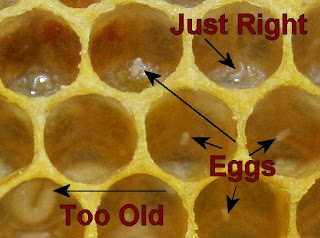Question: How early can you split a hive in the spring? What about the cold at night?
The key to deciding when to split is the presence of drones, and outside temperature during the day.
- If you see drones flying, or hatched in your hive, then there will be drones available for mating your queen. Of course, she doesn’t mate with her own drones (she flies farther away from the hive than they do), but you can figure that if your hives have drones, so do others.
- The queen will not fly to mate unless it is about 69 degrees. If she can’t fly, she can’t mate. (The article cited below states 67.8 as the average *).
If you are adding a mated queen to your split instead of relying on the hive to raise a queen, you can split earlier.
As to the cold, my favorite way of splitting solves that problem, as it ensures that there are enough nurse bees on the frames of eggs to manage the temperature, and a good amount of forager bees. Only split a healthy hive with loads of resources (bees, honey, and pollen) to ensure a good environment for raising a queen.
- Pull 1 or two frames with eggs (not young larva but eggs before hatching), and at least 2 frames of honey and one of pollen, into a hive box, being careful not to take the queen.

Credit: www.honeybeesonline.com
- Add a queen excluder on top of the original hive to keep the queen down.
- Turn your original hive 180 degrees so that the old entrance faces the opposite direction.
- Add your spilt box on top of the queen excluder.
- Add a top entrance on the split box that faces the same way the old hive entrance faced. That way returning foragers will find the entrance to the split box. This is especially true if the original hive had a top entrance, a good practice I think.
- Wait at least 12 hours.
- Pull the split box off and move it 2 miles away OR (this is what I do) move the split box to another location in the apiary and, either completely block the entrance for 48 hours, or partially block it with branches and sticks or grass to force them to struggle out of the hive. This will force the bees in the split to re-orient . **
- Do this late evening or very early morning when the foragers are in the hive. Do not mess with hives after dark unless you like hanging out with very defensive, angry bees crawling over you looking for anything to sting!
- Turn the original hive back around so that the entrance faces in the original direction.
Wait.
Sit on your beesuit.
Do not disturb the split box for at least a month (14-15 days for the queen to hatch, 6+ days for her to be fertile, 4+ days to mate – or longer if the weather is not cooperative, and then several days before she starts laying.) It is a very sensitive time for the bees, and as a backyard beekeeper, I can afford to leave them in peace.
After a month, check to make sure you have a queen. Do a quick check for eggs or young larva and then add the hive into your normal inspection schedule. If there is no queen, you can add the bees back to the original hive using the newspaper combine method.
I actually prefer using swarm cells to split because I think you might get a better quality queen with a swarm cell than an emergency cell (using the split above creates an emergency cell situation), but have used this very successfully as a preemptive, swarm control split.
What I’ve described is similar to using a Cloake Board to raise queens. Instead of raising queens, we are taking a little more time than a simple Walk Away Split to ensure an adequate number of nurse and forager bees in the split. Rusty at Honey Bee Suite (one of my favorite beekeeping blogs!) has an excellent description of a using a Cloake Board To Raise Queens.
This kind of split could also be seen as a modification of a “WalkAway” split, with the added step of ensuring the split frames are adequately covered with nurse bees and foragers.
Check out this article on queen biology and function within the colony.
* For more details on the queen’s mating requirements: “Observation of Mating Behavior of Honey Bee Queens...”
** Michael Bush has a great article on Moving Bees 100 Yards or Less :
Contributed by Ellen Wright

